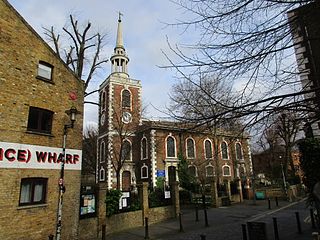
Rotherhithe is a residential district in south-east London, England, and part of the London Borough of Southwark. Historically the area was the most northeastern settlement in the county of Surrey. It is located on a peninsula on the south bank of the Thames, facing Wapping and Limehouse on the north bank, and is a part of the Docklands area. It borders Bermondsey to the west and Deptford to the south east.

The Surrey Commercial Docks were a large group of docks in Rotherhithe, South East London, England, located on the south bank of the River Thames.
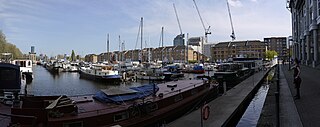
Greenland Dock is the oldest of London's riverside wet docks, located in Rotherhithe in the area of the city now known as Docklands. It used to be part of the Surrey Commercial Docks, most of which have by now been filled in. Greenland Dock is now used purely for recreational purposes; it is one of only two functioning enclosed docks on the south bank of the River Thames, along with the smaller South Dock, Rotherhithe, to which it is connected by a channel now known as Greenland Cut.
South Dock is one of two surviving docks in the former Surrey Commercial Docks in Rotherhithe, London, England. It was built in 1807–1811 just south of the larger Greenland Dock, to which it is connected by a channel now known as Greenland Cut; it also has a lock giving access to the River Thames. Originally named the East Country Dock, it was renamed in 1850 when the Surrey Commercial Dock Company purchased and enlarged it. Timber and grain were the main products imported and exported in the dock.

HMS Queen was a 110-gun first-rate ship of the line of the Royal Navy, launched on 15 May 1839 at Portsmouth. She was the last purely sailing battleship to be completed - subsequent ones had steam engines as well although all British battleships were constructed with sailing rig until the 1870s.

The River Neckinger is a reduced subterranean river that rises in Southwark and flows approximately 2.5 kilometres through that part of London to St Saviour's Dock where it enters the Thames. What remains of the river is enclosed and runs underground and most of its narrow catchment has been diverted into other combined and surface water sewers, flowing into the Southern Outfall Sewer and the Thames respectively.
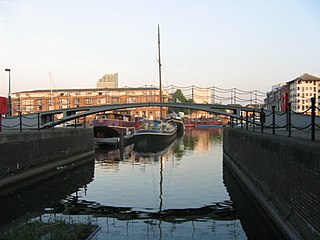
The Grand Surrey Canal was a canal constructed in south London, England during the early 19th century. It opened to the Old Kent Road in 1807, to Camberwell in 1810, and to Peckham in 1826. Its main purpose was to transport cargo, primarily timber to the Surrey Commercial Docks.
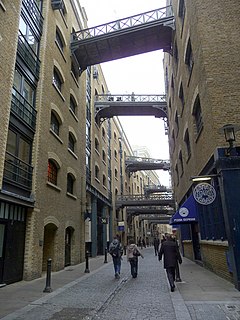
Shad Thames is a historic riverside street next to Tower Bridge in Bermondsey, London, England, and is also an informal name for the surrounding area. In the 19th century, the area included the largest warehouse complex in London.

Russia Dock Woodland is a long narrow park in Rotherhithe, London, created by the infilling of one of the former Surrey Commercial Docks. The former Russia Dock was originally used for the importing of softwood timber from Norway, Russia and Sweden. Known as "deal wood", it was mostly used for newsprint and for manufacturing furniture.
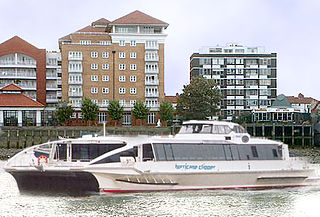
New Caledonian Wharf is a luxury gated community in the Rotherhithe area of London on the River Thames. The site was originally part of the Surrey Docks and known as Redriff Wharf, and served as a commercial wharf until the 1970s.
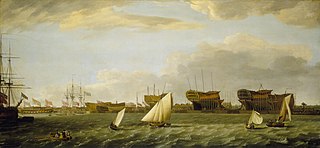
Blackwall Yard is a small body of water that used to be a shipyard on the River Thames in Blackwall, engaged in ship building and later ship repairs for over 350 years. The yard closed in 1987.
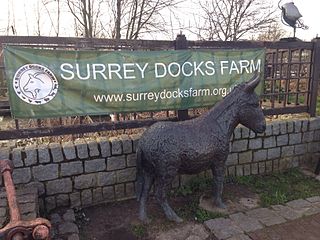
Surrey Docks Farm is a working city farm in the heart of London. It occupies a 2.2-acre (8,900 m2) site on the south bank of the River Thames in Rotherhithe.
The Pageants was a shipyard in Rotherhithe on the River Thames, London. It was established in the early 18th century and one of its first occupants was John Buxton of Deptford. After being used by Buxton for construction of Navy ships between 1741 and 1744 the yard fell into decline, possibly being used to store timber and later as a ship-breakers.

Cox & Hammond's Quay was a wharf located in the City of London, on the north bank of the River Thames a short distance downstream from London Bridge. It was originally two separate quays, Cox's Quay and Hammond's Quay, separated by Gaunt's Quay. On the landward side, the wharf was accessed via Lower Thames Street just behind the site of the church of St Botolph Billingsgate.
The Condemned Hole was a site in Rotherhithe on the River Thames occupied by HM Customs and Excise for the collection of flotsam and jetsam and ships which had been seized for contraband activities. It was closed in 1962. It was one of a number of sites known as the King or Queen's Pipe on account of the burning of condemned tobacco and food, illicit books and other contraband on the site.

The Rotherhithe crossing is a proposed route for pedestrians and cyclists across the River Thames in London, England between Rotherhithe and Canary Wharf.

Columbia Wharf, on the south bank of the River Thames in London, was the first grain silo in a British port. Built in 1864, it was designed by architect and hymnwriter James Edmeston for G & I L Green's Patent Ventilating Grain Company. It is in Rotherhithe, south of Cuckold's Point and north of Nelson Dock Pier. Canada Wharf was added to the complex in 1870–1. Used for storage of foodstuffs until 1976, the complex, including a former engine house and boiler to the south, was listed as a Grade II building in 1983, and is now used for accommodation.
Botolph Wharf or St Botolph's Wharf was a wharf located in the City of London, on the north bank of the River Thames a short distance downstream from London Bridge. It was situated between Cox and Hammond's Quay upstream and Nicholson's Wharf downstream. On the landward side, the wharf was accessed via Thames Street. It had a frontage of 78 ft (24 m). The wharf was used for at least a thousand years before being destroyed during the Second World War. A late 1980s office building currently occupies the site.

Nelson House, also known as Nelson Dock House, is a Grade II* listed building on Rotherhithe Street in the London Borough of Southwark. The house was built in the 1740s in the Georgian style and was historically home to shipbuilders including John Randall. The house is named after Horatio Nelson, 1st Viscount Nelson.
















